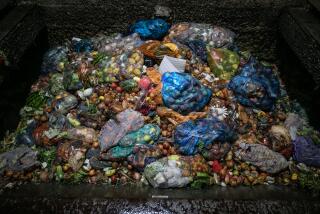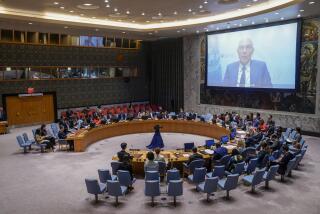Planting Season Heralds Battle to Feed N. Korea
- Share via
KAESONG, North Korea — With ox-drawn hoes, the occasional tractor and armies of planters seeding the fields by hand, North Korea has mobilized its antiquated farm industry for the annual battle to fend off starvation.
As spring planting begins, the communist government insists the famines of the 1990s are long past. But it is also seeking food aid from China, South Korea and the United Nations World Food Program, suggesting to foreign experts that once again the harvest will fall short.
Last month, North Korea and the WFP agreed on a reduced feeding program to cover 1.9 million North Koreans, down from the 6.5 million the agency had previously fed.
That may not be enough, the agency says. It warns of millions being at risk, such as urban workers who have no land on which to grow extra food, and no money to buy it.
Harvests and aid distribution have improved, but “we’re concerned about the neediest and most vulnerable who will not benefit from that,” Tony Banbury, the WFP’s regional director for Asia, said.
The North Koreans can produce about 80% of the 5.5 million tons of food they need, “but they’re still a million tons short,” he said.
The rest is expected to be made up by 500,000 tons from South Korea, about 300,000 to 400,000 tons from China and 75,000 tons from the WFP, Banbury said.
It’s not known exactly how many people died during the famines that followed the collapse of the Soviet Union, which had provided crucial support to North Korea. Estimates of the death toll from what the regime calls the “arduous march” go as high as 2 million, blamed on outmoded farming methods and natural disasters.
Some experts believe the reclusive regime of Kim Jong Il sought to end the U.N. program because of its strict monitoring conditions -- about 500 visits a month to make sure the food was getting to the needy and not being diverted to the elite or the military. South Korea conducted only 20 such visits in all of last year.
During a tour to North Korea in May by a delegation of international taekwondo masters, officials took pains to demonstrate that food was plentiful.
On a stroll through a park in the capital, Pyongyang, visitors were greeted by students having a lavish picnic and were invited to share their rice rolls, dumplings and kimchi. North Korean officials escorting the group urged journalists to take pictures during the tightly choreographed trip.
At restaurants, foreign guests were plied with course after course for a virtual all-you-can-eat experience.
In the countryside, neat lines of workers bent over to plant rice in paddies brimming with water. In Kaesong, on the heavily fortified border with South Korea, it seemed every possible piece of flat earth and terraced hill was being cultivated.
Planting usually begins in April but was postponed for a month because of an unusually long winter. One of the visitors’ North Korean escorts, Choe Chang Hyok, blamed climate change -- apparently taking his cue from theories advanced in the state-controlled media.
He then turned lyrical, saying: “We live on Earth, and our next generation will live on Earth. If we don’t love the forest and water, then where will the next generation live?”
North Korea can’t be accused of significantly adding to carbon dioxide in the atmosphere, the factor widely blamed for global warming. Virtually no one in North Korea owns a car. But the number of villagers seen on bicycles suggested a possible rise in living standards.
Buses were carrying city people to their mandatory 20-day stint helping out in the countryside. A farm that finished its planting ahead of others received media plaudits.
“Farmers finished planting potatoes within 10 days with enthusiasm, working from early mornings till late in the night,” the newspaper Rodong Sinmun reported, adding: “The great leader Kim Jong Il said that potatoes are a crop with a high yield.”
More to Read
Sign up for Essential California
The most important California stories and recommendations in your inbox every morning.
You may occasionally receive promotional content from the Los Angeles Times.













